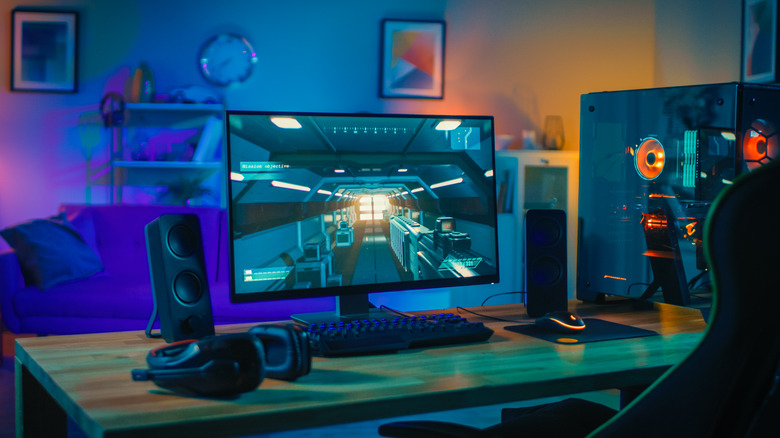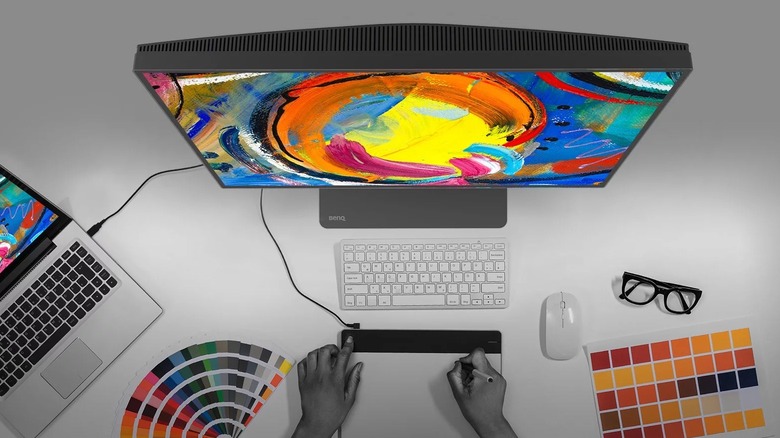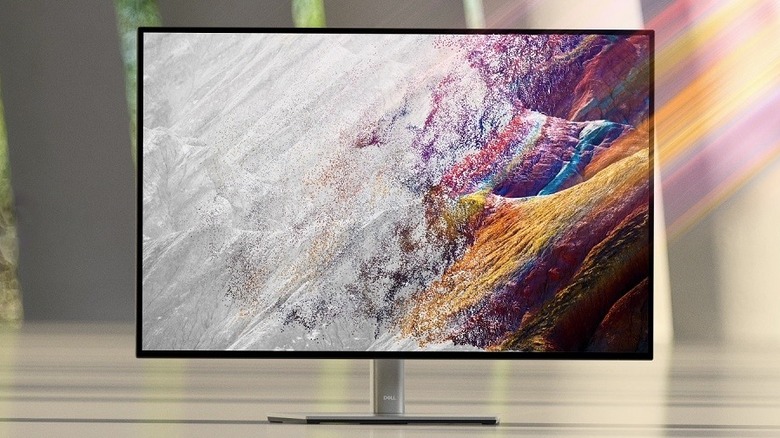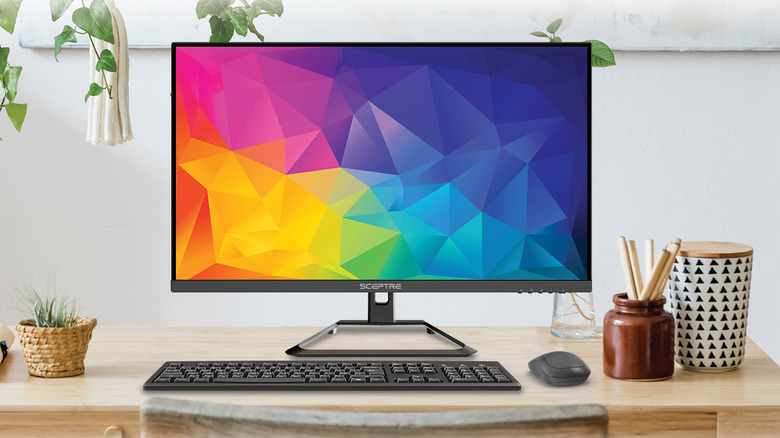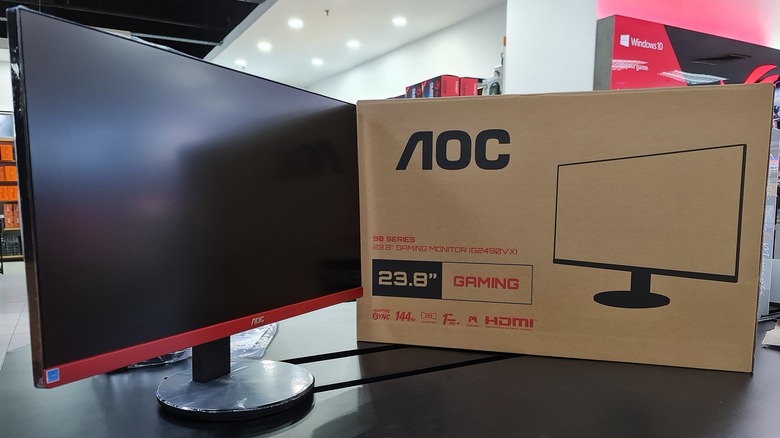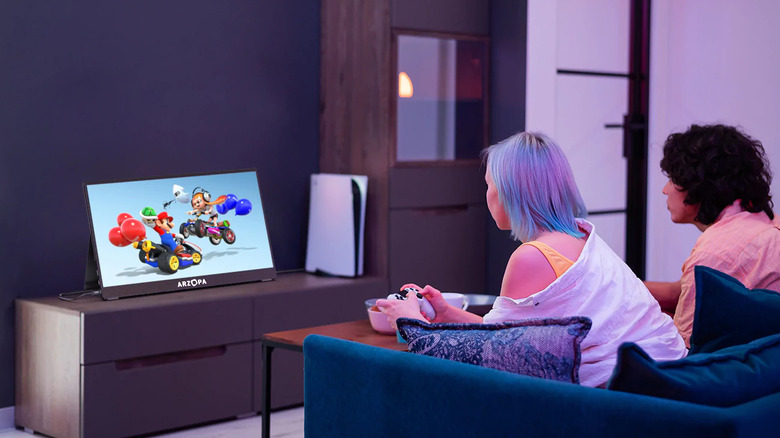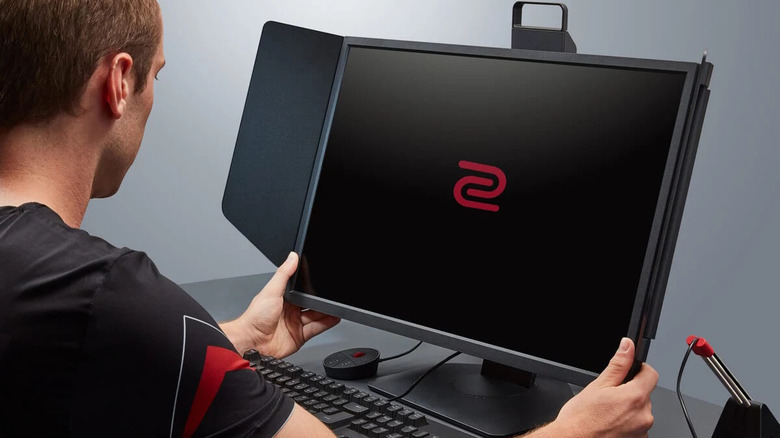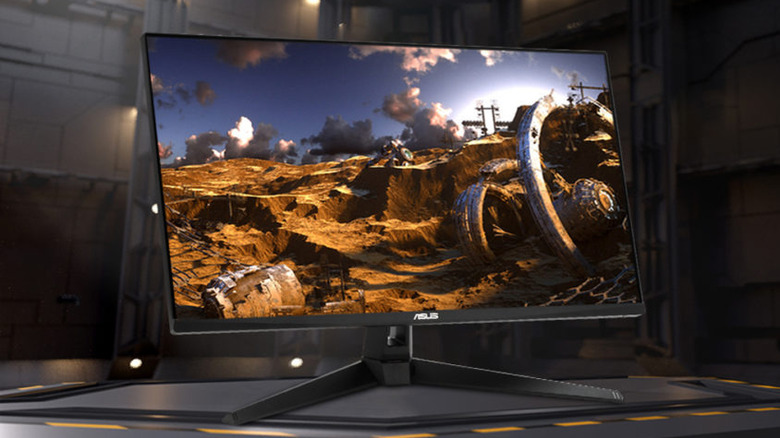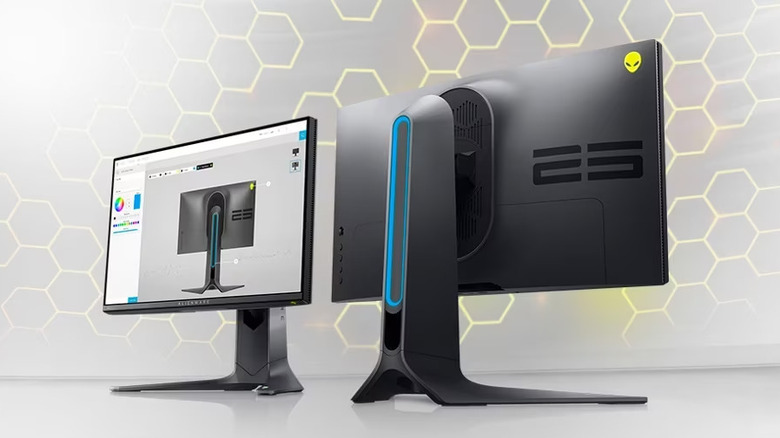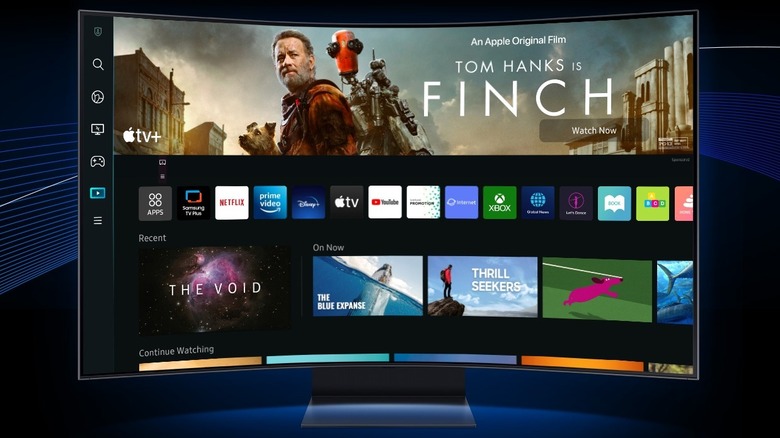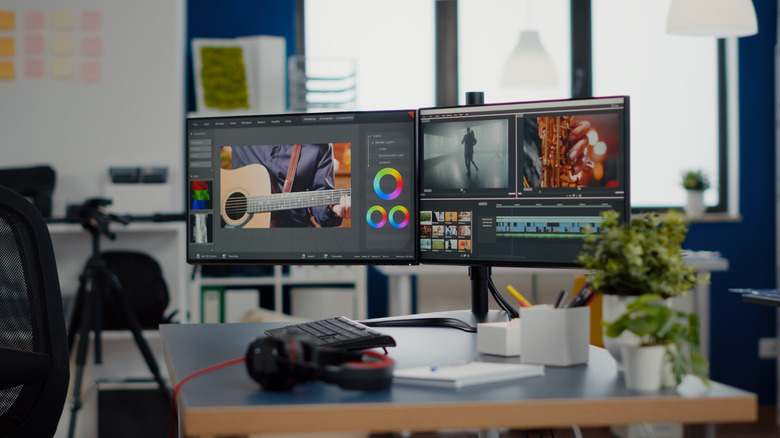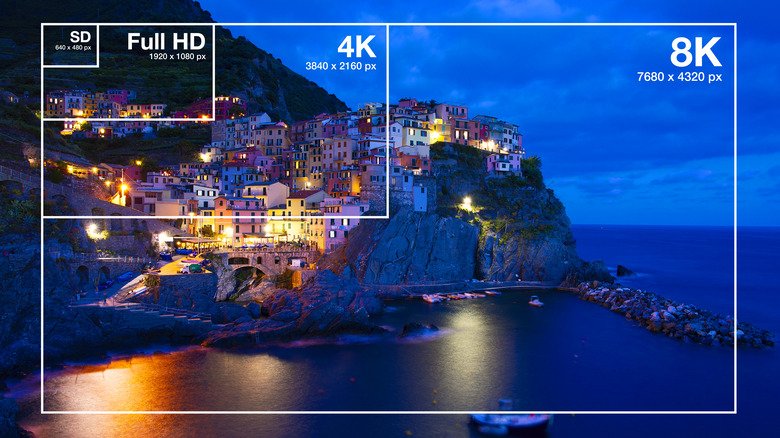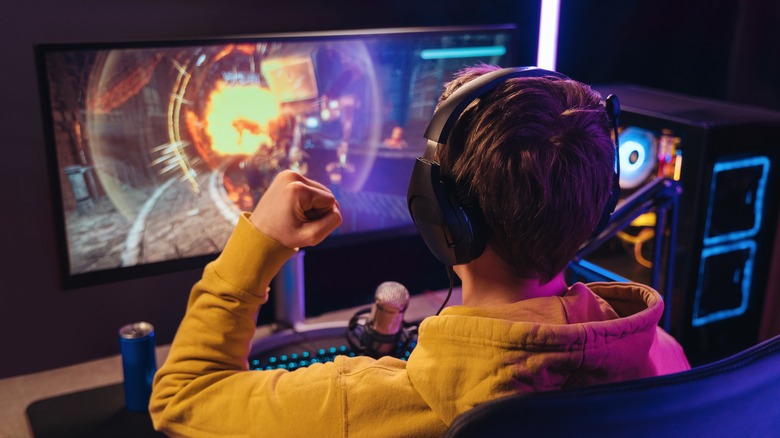The 10 Coolest PC Monitors You Can Buy Today
As the computer industry matures, users are presented with a range of PC monitor options, many stacked with custom settings and fancy new technologies. However, how do you identify the really good monitors? SlashGear dove into research and comparisons of the best computer monitors on the market right now and assembled the 10 coolest PC monitors that you can buy across a variety of categories and price ranges. The usual brands are represented, along with some lesser-known options.
The findings were quite stark. It turns out that you don't have to spend a bunch of money to get a decent monitor that will serve most purposes quite well. But if you do decide to go all in, the reward can be more than worth the purchase price. Whether it's a productive office monitor, a designer-friendly display, or a 4K gaming experience that wraps around your field of vision, this list has you covered.
BenQ GW2780
Many assemble their home workstation on a budget. They may have a better display at the office, and a cheap monitor for those stay-at-home days should do just fine. Inexpensive monitors tend to cut corners and deliver sub-par experiences. But that's not the case with the BenQ GW270. At just $140, the GW270 streamlines productivity while providing comfort and style to match.
As a workstation monitor, the BenQ GW2780 has a full 1080p IPS panel and includes built-in speakers. The great part about this IPS panel is the 178° horizontal and vertical viewing angles, so you can tilt the screen to your liking while maintaining incredible visibility. The GW2780 also sports an ultra-slim bezel design with a cable management system that hides clutter for a clean appearance. With HDMI, VGA, and DP ports, you'll be up and running in no time with connectivity options for all platforms.
BenQ has also thrown in a few high-end features found on their premium models. The Proprietary Eye-Care Tech includes a Brightness Intelligence setting that detects light levels and adjusts the color and temperature of the screen to match your surroundings. The Low Blue Light Technology also filters out blue-violet radiation which can potentially eliminate irritation and reduce fatigue during long periods of work. Therefore, to protect your eyes on a budget, the GW2780 is the way to go.
BenQ PD3200U
As a designer, color accuracy within a monitor is paramount. The BenQ PD3200U is a $569 4K 32-inch IPS monitor that is both Calman-verified and Pantone-validated. Every monitor is individually pre-calibrated and includes a certification report. You can therefore guarantee out-of-the-box trustworthy color performance, so whatever you design is true to multiple industry-standard color gamuts.
In addition to its basic color accuracy, the BenQ PD3200U also adapts to your environment and art type, the brand notes. Various modes can bring an extra layer of detail to your work. For example, instead of using a generic Night light that adds warmth to your screen, Darkroom Mode adjusts the brightness and contrast only. Your eyes can remain comfortable while maintaining the accuracy of your artwork. Other useful modes include Animation Mode, which enhances the clarity of dark regions without overexposing bright areas, and CAD/CAM Mode which boosts the contrast of lines and shapes. You can also enable DualView. This lets you split the screen in half, and have an illustration in CAD/CAM Mode, and a design in sRGB.
In terms of an ergonomic design, you'll be able to tilt, pivot, and swivel just about anything to your preference. Once you've found the best position, connect via HDMI, DisplayPort, mDP, or USB hub. As a designer, moving toward 4K is good, but choosing a color-accurate panel is best. The BenQ PD3200U delivers the best of both worlds.
Dell U2723QE
Finding a premium business monitor can be a challenge. You'll likely want to balance performance and productivity, while still having a display that looks professional. While gaming monitors can offer amazing specifications, their RGB backlighting can be somewhat of a distraction. The Dell UltraSharp U2723QE offers a platinum silver finish complimented by a cable management system that keeps things neat. Sleek and sophisticated on the outside, on the inside, the UltraSharp U2723QE is the world's first 4K 27-inch monitor that includes IPS Black technology. This allows the monitor to output a much deeper black color when compared to regular IPS panels. Visuals are incredible thanks to the larger 3840 x 2160 resolution and 2000:1 contrast ratio. You'll be able to see finer details while enjoying true-to-life color with 98% DCI-P3 and VESA DisplayHDR 400.
The monitor also offers unique productivity features. You can connect two PC sources at the same time and control them with the same mouse and keyboard via the KVM switch. Easy Arrange lets you tile multiple applications across your screen, so you can multitask without minimizing. If you'd like to go a step further, you can even daisy chain an additional 4K monitor at full resolution via USB-C. As one of the best 4K experiences available right, expect to pay around $500 for the UltraSharp U2723QE.
Sceptre U275W-UPT
The Sceptre U275W-UPT is a budget-friendly 4K monitor that delivers crisp images for under $200. It has a borderless 27-inch design, which resembles the appearance of a high-end monitor. While the bottom base isn't the best design choice, it can be replaced using a VESA wall mount pattern. You'll therefore be able to attach a third-party monitor arm and position the U275W-UPT however you like. The IPS panel also comes in handy here as it maintains sharp visibility from all viewing angles. The colors maintain their vibrant and eye-catching appeal, thanks to the 350 cd/m² brightness. Although it's not anywhere near the standard of something like the BenQ PD3200U's color calibration, for example, it still looks pretty good.
Those looking for an entertainment station will therefore find a lot to like with the Sceptre U275W-UPT. The monitor has built-in speakers, so in between your workload breaks, you can load up YouTube and listen to your favorite videos without needing a headset. The monitor also comes with a higher 70 Hz refresh rate, and although it isn't marketed for gaming, it would handle most casual games at 4K quite easily. Just be aware that to activate the 70 Hz refresh rate correctly, you will need to do so via a DisplayPort connection (cable included), otherwise, an HDMI will default the display to 60 Hz.
AOC G2490VX
When selecting a monitor, gamers often prioritize a fast refresh rate to keep up with their high frame rates. Others focus on the picture quality that comes from high resolution or a specific panel type. With all these attributes increasing the potential asking price, the AOC G2490VX is a monitor that offers all of the above at a sub-$130 price.
With a 24-inch 1080p VA display paired with a 144 Hz refresh rate, the AOC G2490VX strikes the perfect balance between high-end performance and cost. The VA panel offers gorgeous colors that bring virtual worlds to life with highly contrasting details. The bumped-up refresh rate paired with a 1080p resolution is also great for competitive gamers. They can preserve their frame rate while gaining the advantage of a faster response time.
What makes AOC even more unique is their 3-year RE-SPAWNED Warranty option. If you happen to find a dead pixel or a bright dot within 3 years of purchase they will replace your monitor for free and they'll ship your replacement as soon as the RMA is authorized. There's a 1-year accidental damage plan, in case your monitor unexpectedly falls off your desk while you're raging.
Arzopa G1
The Arzopa G1 monitor is a portable display that is ideal for traveling. While portable monitors aren't a new thing, the Arzopa G1 offers a new meaning to connectivity options for those on the move. It can be connected via iPhone, iPad, MacBook, laptop, PC, Nintendo Switch, PS5, and an Xbox Series X. Above all, the G1 is a plug-and-play experience with no charging necessary. Users simply need to connect it via USB-C cable and they'll be good to go.
While things get bumpy on the road, the Arzopa G1 features a smart magnetic cover that is both durable and waterproof. The body itself is made out of a strong metal complimented by a lightweight design at just 1.44 lbs and 0.35 inches in thickness. The G1 has an incredible 15.6-inch 144 Hz IPS display that is on par with most gaming laptops.
The Arzopa G1's refresh rate will still be bound to a console's maximum FPS limit. Therefore the PS5 and Xbox Series X will default to 120 Hz, though users can increase productivity and multitasking by setting up the landscape and portrait modes. Scan through notes, edit photos, or enlarge an important document — it's never been easier to set up a secondary display for under $200.
BenQ ZOWIE XL2546K
With the rise of esports, a lot of monitor manufacturers are claiming their gaming monitors provide a competitive advantage. In most cases, they're advertising high refresh rates and a panel with a fast response time or little-to-no input delay. While these features are certainly important in FPS games, one monitor has remained a favorite amongst most pros over the years, the BenQ ZOWIE XL2546K.
At around $499, the ZOWIE XL2546K offers unique features that can put you ahead of your opponents. The 24.5-inch 1080p display includes the unique DyAc+ Technology. This allows gamers to experience less blur while performing vigorous actions on screen. For example, if you're shooting rapidly, DyAc+ can kick in and help you position your crosshair better to improve spray control.
The fast 240 Hz refresh rate is also strengthened by a Black eQualizer setting that can improve lighting in dark areas, for example, If an enemy is hiding in a corner. Additionally, you can adjust the color vibrance on the monitor itself, great if you're a fan of colorful saturated images. Finally, the most inviting design feature is the smaller base. This allows gamers to position their keyboards at various angles while sitting closer to their monitor.
ASUS VG32VQ1B
The early 2000s were the golden age of console gaming at 32 inches. If you had a 1080p resolution, you were the cool kid in the party chat. Although we've come a long way since our 60 FPS 60 Hz days, some fundamentals never die. The ASUS TUF Gaming VG32VQ1B fills the current niche. The immersive 32-inch display comes with a 2560 x 1440 resolution and a 165 Hz refresh rate. The higher 1440p resolution in particular provides a crisp image with good pixel density. It might be a bit too big for competitive PC gaming, but in terms of sitting back and relaxing, this is a console gaming dream.
When looking at its specs, the ASUS VG32VQ1B closely resembles some of BenQ's premium monitors. It has its own Ultra-Low Blue Light Technology that comes in four different filter settings that help reduce the amount of blue light emitted from the display. You'll also find Extreme Low Motion Blur (ELMB), which is similar to DyAc+, and a Shadow Boost Technology that resembles Black eQualizer. While these features and the $328 price tag are good, we'd still lean toward the BenQ XL2546K for competitive gaming and overall quality.
Alienware AW2521H
Alienware designs are usually futuristic in nature with custom AlienFX lighting to satisfy RGB-gamer needs. Shaped with thin bezels, a matte white or black finish, and the classic alien logo, the $420 AW2521H is one of the fastest gaming monitors available right now. The AW2521H is G-Sync certified so you can experience tear-free images in-game. The adaptive sync technology will match the refresh rate to your computer's frame rate for a buttery smooth experience. Even if you can't reach 360 FPS to fully utilize the 360 Hz display, at least you have the capability to do so when you eventually decide to upgrade your system.
The monitor's exceptionally high refresh rate does raise an important question though. Shouldn't the 1 ms response time and 360 Hz refresh rate make it the best monitor for esports? That's up for debate. The AW2521H doesn't offer any motion clarity technology, and the additional color modes (such as warm or cold) aren't really catered for e-sports. You've also got to consider the 1080p 24.5-inch display isn't going to provide the clarity a 1440p monitor would.
However, the IPS panel provides rich colors that are way more inviting when compared to fast TN panels at the same refresh rate. While it doesn't have the distinct Black eQualizer appearance of a BenQ XL2546K, it's a beautiful display nonetheless.
SAMSUNG Odyssey Ark S55BG970NN
The 55-inch curved Samsung Odysessy Ark is an enormous gaming monitor developed to overwhelm the senses. The Ark wraps around your field of view with its incredible 4K resolution and 165 Hz refresh rate. The result is an experience that is not only otherworldly but fluid and smooth at the same time. Although the Odyssey Ark is sold under the gaming category, it has something for everyone with its Multi-View feature that allows users to separate the display into four individual screens. With built-in apps such as YouTube, you could simultaneously watch videos on Twitch, and chat with your friends in Discord, while playing your favorite game.
You'll be able to tilt and pivot just like any regular 24-inch monitor. Moreover, turning the Odyssey Ark vertically will allow you to enter Cockpit Mode. This specialized feature lets you split the screen into three screens, one on top of the other using three different display inputs. The Samsung Odyssey Ark includes HDR10+ which automatically adapts games in real-time to show every detail. The 1,000,000:1 contrast ratio is even better for movies and videos as it enhances color expression and depth. Although the asking price of $2,750 is steep, this monitor can certainly elevate your entertainment.
The difference between TN, VA, and IPS monitor panels
Every monitor has a different kind of panel technology, each with its own strengths and weaknesses that can determine the category of consumer it's suitable for. The most common types used today, according to BenQ, are TN (Twisted Nematic), VA (Vertical Alignment), and IPS (In-Plane Switching). TN panels offer high refresh rates, fast response times, and deep black levels at an affordable price. They usually have low input latency so they're ideal for competitive gamers. The downsides, however, are disappointing colors and low contrast levels. Additionally, the viewing angles can be pretty bad.
VA panels offer incredible colors and are suited for those who want the best picture quality. They are rich and vibrant with high-contrast ratios over 3000:1. Similar to TN panels they have good black levels, but their viewing angles are not so great. Unfortunately, they suffer from slower response times, so they're not ideal for quick-reaction activities.
IPS panels tend to be a good middle ground between TN and VA panels. However, they're usually the most expensive. IPS panels offer great color performance but have the advantage of a speedy response time. They also have better viewing angles, and often support a high refresh rate. If you want an all-purpose monitor and have the budget to spare, IPS panels are the way to go.
Resolution and screen size versus pixel density
When choosing a monitor, the resolution is one of the most important aspects that determine picture quality and clarity. You'll often see monitors advertised with a full HD resolution. What manufacturers fail to warn you about is the impact your monitor size will have on the advertised resolution. Pixel density is therefore an indication of how many pixels per inch are displayed on your monitor. The higher the pixel density, the clearer and sharper the display will be. Monitors that have a lower pixel density will appear blurry and pixelated.
For work, school, and entry-level gaming, a pixel density of 92 PPI (pixel per inch) is more than enough. On the other hand, if you're interested in photo editing, designing, or detailed gaming, then you should opt for a monitor with around 110 PPI or over. You can find out a monitor's pixel density and PPI measurement using a Pixels Per Inch Calculator.
Remember, a higher resolution will place more demand and stress on your computer's graphics card. Your computer may handle a 1080p resolution perfectly fine, but pushing it to 4K may lead to stutters and FPS drops. You'll therefore have to weigh the viewing size you want, with a resolution that creates a good pixel density while taking into consideration the capabilities of your computer.
Monitor refresh rate and adaptive sync
A monitor's refresh rate is a measurement of how many times per second a new image can be displayed. For example, a 75 Hz monitor will refresh 75 times per second. This means that when there is movement on your screen, a higher refresh rate will output a smoother experience and reduce input lag. If you don't play video games then a 60 Hz monitor will do just fine. You're better off spending your money on higher resolution. Those who want to play video games will likely start at 144 Hz, and upgrade as they become more competitive. While there is a massive leap from 60 to 144 Hz in terms of performance, anything above 240 Hz is a luxury.
You've also got to take into consideration the hardware of your computer. When your frame rate doesn't align with your monitor's refresh rate, screen tearing can occur. You'll therefore need a monitor that supports adaptive sync.
Adaptive sync is a monitor technology that changes your refresh rate to the current frame rate. The most popular versions are NVIDIA G-Sync and AMD FreeSync. Adaptive sync decreases screen tearing and thus alleviates the effects of inconsistent frame times and additional input lag. In a nutshell, a high refresh rate is awesome, but ensure your monitor can adapt to maintain a visually consistent performance.
